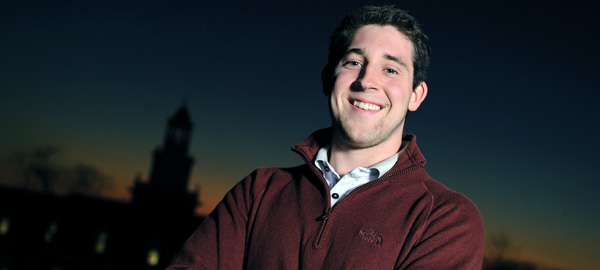
When NASA launched its Radiation Belt Storm Probes on August 30, one Johns Hopkins undergraduate took particular interest in the event. Terence Casey, a 21-year-old junior, spent the 2011–12 academic year working on the space project as a full-time paid intern at Hopkins’ Applied Physics Laboratory (APL). APL built the spacecraft and is managing the mission for NASA.
Casey secured the internship after meeting Raymond J. Harvey, an APL aerospace engineer who led the mission team, when Harvey guest-lectured in a Mechanics- Based Design class at the Whiting School. While Casey’s primary interest is in aviation and aircraft design, he says he was intrigued by Harvey’s presentation and contacted him about joining the team.
The project (recently renamed the Van Allen Probes to honor the scientist who discovered the radiation belts in 1958) is the first twin-spacecraft mission designed to explore the Earth’s Van Allen belts, which are hazardous regions of space that contain highly charged radiation particles. These radiation belts are susceptible to damage from solar storms and other cosmic disturbances, in turn posing dangers to communications, GPS satellites, and human spaceflight.
The NASA satellites will navigate the belts for two years, transmitting data about the conditions they encounter. A big part of Casey’s work for the mission involved simulations testing of various data collection instruments, as well as using software to organize and display data as it comes in from the satellites. He also helped write computer codes to send commands to the satellites.
Casey says the computer science training he obtained in his Freshman Experiences in Mechanical Engineering class prepared him well for the internship. “It was a huge help. If I didn’t know computer science at all, it would have been impossible for me to follow the logic,” he says.
Working at APL was invaluable in demonstrating the practical applications of mechanical engineering course work, Casey says. “Now I can see how the different courses actually overlap and relate to one another,” he says. “APL is a great place to work,” says Casey. “They let you move around and work on different projects.” While he still has 18 months to go before he graduates, Casey said he is very interested in working at APL after he earns his BS in 2014.




